
Tower of Babel ©
"Let us build us a city and tower, whose top may reach unto heaven." Genesis.11:4
The Tower of Babel was an astronomical observatory.
Thoth was the god of wisdom and learning. He was "the counter of the stars."
 The Tower of Babel was an astronomical observatory. Looking at the stars without taking measurements isn't astronomy. The Tower of Babel wasn't a place where people climbed up high to gaze at the stars. They could stargaze standing on the ground. The Tower of Babel was a scientific astronomical observatory. It was an astronomical instrument for measuring the movements of the heavens.
The Tower of Babel was an astronomical observatory. Looking at the stars without taking measurements isn't astronomy. The Tower of Babel wasn't a place where people climbed up high to gaze at the stars. They could stargaze standing on the ground. The Tower of Babel was a scientific astronomical observatory. It was an astronomical instrument for measuring the movements of the heavens.
The Tower of Babel that the Bible describes wasn't a scientific astronomical observatory. The stack of mud bricks the Bible describes wouldn't serve as a measuring instrument. Much of the Bible was compiled from stories and legends that were already ancient before the Bible was written. Astronomy was already a well-developed science long before the Book of Genesis was written. The biblical tale of the Tower of Babel is a mixture of ideas compounded from stories of an ancient tower, the physical presence of the Ziggurat at Ur, and anti-Babylonian sentiments.


 The Tower of Babel was not a brick pyramid towering above the walls of Babylon. The Tower of Babel was a tower. The Tet tower that represents the backbone of Assur is a graphic representation of the Tower of Babel.
The Tower of Babel was not a brick pyramid towering above the walls of Babylon. The Tower of Babel was a tower. The Tet tower that represents the backbone of Assur is a graphic representation of the Tower of Babel.
(NOTE: The original Tet tower, before the resurrected one, may not have been in Babylon. It may have been in pre-Egyptian Egypt.)
In Egyptian Pagan symbolism, the backbone of Assur represents social order, stability, and security. The heavens are orderly, enduring, and stable. The stars are dependable and secure. Those ancient people lived in political and economic uncertainty in an unstable world. Every generation experienced plague, famine, and civil unrest. Heaven was the only really secure thing those people knew.
According to the legend of Assur and Isis, a company of conspirators murdered Assur. They hacked his body into pieces and scattered his severed parts. Isis gathered together Assur's parts and resurrected him from the dead. The part that represents Assur's backbone is not a picture of his backbone. The Tet tower depicts a scientific astronomical observatory. The Tet figure is a picture of an instrument for measuring the movements of the heavens.
Ancient astronomers made their astronomical observations at the horizon. They had no instruments for taking accurate measurements overhead as modern astronomers have. The four "levels" on the Tet were balconies that ran around the outside of the tower. Those were false horizons. The natural horizon on the ground is irregular. The ancient astronomers couldn't make consistent and accurate astronomical measurements on the natural horizon. They created false horizons on a tower to get them above the natural terrain. They kept their horizons level by measuring up from water in a moat around the base of the tower.
The four horizons on the tower served different purposes. One was for solar observations. Another was for stars. One was for the moon. And one was for planets. The astronomers worked inside the tower. They observed the passages of celestial objects across their respective horizons through slots and slits in the tower walls. They sighted from a plumb-line suspended in the center of the tower. By means of this ancient astronomical instrument priest/scribes of the Thoth school mapped the major movements of the heavens in very early times.

Priest scribes of the Thoth school were wordsmiths. They formulated words.
According to the Pagan foundation legend, Thoth was the scribe of the gods. Thoth was the inventor of writing and of numbers. Thoth was the all around god of wisdom and learning. Priest/scribes of the Thoth school were the Pagan intelligentsia of their time. They were scientists, engineers, mathematicians, healers, and astronomers. They were administrators of governments and teachers in schools that used many languages. In their need to communicate in a world of many languages, priest/scribes of the Thoth school modified, codified, and unified the languages of their day. They used religious icons and names of gods to formulate words and give them meanings.
Priest/scribes of the Thoth school were wordsmiths. They "gave names to things which formerly had none." Our language is a mixture of natural words and formulated words. Some words we use are natural words that evolved from original "wild" languages. Some words are formulated "Thothian" words that priest/scribes of the Thoth school created.
Thoth was the god of wisdom and learning. The name Thoth is the root source of our word thought. Gods and powerful individuals had multiple names. Tekh was another of Thoth's names. Thoth's name Tekh is the root source of the syllable tech- in our words tech-nology, tech-nique, and so on.
Thoth's name lends meaning to a number of formulated Thothian words and names. The name of the Tet tower is one of them. Tet is another derivative of Thoth's various names. The name of the Tet tower is the source of our common word tit. The Tet tower stuck up from the landscape like a tit. The Tet is the tot- syllable in the word tot-al. It is the tit- in tit-le. It is the tit- in tit-ans and the Teut- in Teut-ons. The Tet may be the Tut in Tut Ankh Amen.
In the book Osiris and the Egyptian Resurrection (p.48), E.A. Wallis Budge used the name Tet to name the icon that represented Assur's backbone. Dr. Budge's source for the name Tet is unknown. Someone later determined that Tet is incorrect and that it should be called djed. The Tet is now widely known as the "djed column." Some people who are uncertain about its "correct" name call it the "tet(djed) column."
It is unlikely that anyone could make such an exact determination of the sound of a word that was in use for 3000 years. No language stays stable that long. Old English is only 500 years older than Modern English, and no one knows how Old English sounded except in a few rare cases. Egypt was a land of multiple languages for 3000 years. Different dynasties from different nomes spoke different languages. The official "State Language" that we know from hieroglyphics probably never was a spoken language. The pronunciation of the written characters changed with every change of dynasty.
 It is possible that both the Tet and djed names of the Tower of Babel are correct. It is possible that the djed name of the tower was used to construct words in some languages. "The Lord did there confound the language of all the earth." The exact opposite was happening there. Languages were being compounded, not confounded, there. On this web site, the Tet is called Tet. That name fits the system that was used to formulate other Thothian words in this language.
It is possible that both the Tet and djed names of the Tower of Babel are correct. It is possible that the djed name of the tower was used to construct words in some languages. "The Lord did there confound the language of all the earth." The exact opposite was happening there. Languages were being compounded, not confounded, there. On this web site, the Tet is called Tet. That name fits the system that was used to formulate other Thothian words in this language.
The Tet towered above the walls of Babylon. It wasn't a ziggurat. It wasn't a djed column.
Resurrect Isis(Asset). She has truly been an Asset to all of humnakind. She can truly be an Asset to all of humankind, now and in the future.
|
Reader responses are invited. |
Link to Home Page . . . Return to Index
Links to related pages: